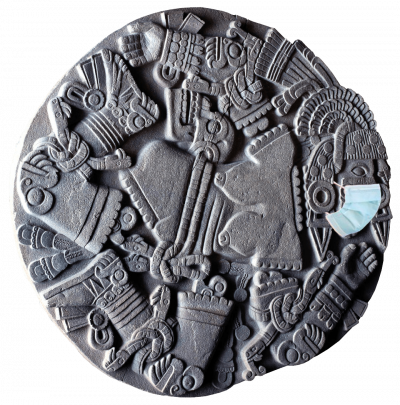
This is a search. A climb, perhaps. A love poem, quizas, or rather, the search for and within a love poem. Love. I’m still searching for what that is: querer vs amar. For the deracinated, the uprooted, the Chicanx… for me, my sacred, immaculate heart is still something to be ripped out and offered to the greater deity of the current time- that great Commerce of the (still) colonial mundo nuevo. But the inheritance for the discovered is scattered, the mind and heart are fractured, ripped apart.
“I stop before Coyolxauhqui’s dismembered body. The warrior goddess’s eyes are closed, she has bells on her cheeks, and her head is in the form of a snail design. Decapitated by her brother,… [she] exemplifies … conquered bodies. Her bones jutting from sockets call to mind the dominant culture’s repeated attempts to tear U.S. Mexican culture apart and scatter the fragments to the winds.”
Fold in, cut up, a Coyolxauhqui re-membered, a la Anzaldua. We took that concept and ran with it as a subculture long ago, no? I sit with so many texts, dismembered like open wounds. Somewhere, in this, I know (hope?) a heart beats. What heart is to be offered at the top of this search, this climb? I am Chicano (the border crossed us, as they say…), not Mexican. And half at that, a border running through my blood. Growing up in Califaztlan, Anzaldua is bible. And yet, not without her own blindspots. Still I always felt a bit of a charade, for even the frontera identity was still once removed from my pocho identity. Never fully anything, but still plenty full-of-something. What is a pocho? Technically, it’s the fruit that falls near the tree and is overripe. Rotten. Spoiled. But it doesn’t translate that way, or rather, it doesn’t context that way. Especially for the güero and half-breed. Neither brown, nor white, nor red: the tongue and heart and mind betray themselves in practice, especially in speech. Thus, a poem: how to translate the heart, how to decolonize my heart? Creeping towards an apocalyptic-corazón, step by step up the temple stairs. Stay with me, I think-hope-pray we’re going somewhere.
“Pocho, cultural traitor, you’re speaking the oppressor’s language by speaking English, you’re ruining the Spanish language,” I have been accused by various Latinos and Latinas. Chicano Spanish is considered by the purist and by most Latinos deficient, a mutilation of Spanish. But Chicano Spanish is a border tongue which developed naturally. Change, evolución, enriquecimiento de palabras nuevas por invención o adopción have created variants of Chicano Spanish, un nuevo lenguaje, Un lenguaje que corresponde a un modo de vivir: Chicano Spanish is not incorrect, it is a living language.”
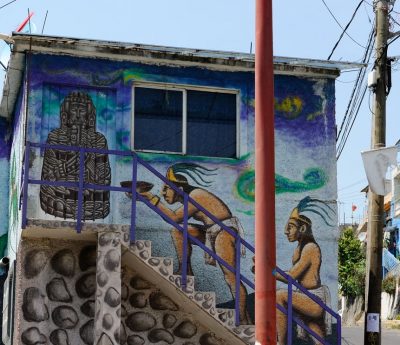
With raging pandemic and virtual classrooms, we are struck not only the ‘language as virus’ of Burroughs (indeed a conception all pochos know well, chale?), but also with a non-metaphoric virus, in all its glory. Two of our group had fallen ill, and trajectories and plans change. Theory unable to manifest in praxis uniformly. Communication becomes important even more, we who were never able to meet in person yet as colleagues, as students, as friends. So here we begin to ponder- what is the language of the virus? What modo de vivir keeps our communication flowing, here in this para-apocalyptic time? Keeping a fathom away from all living beings save those you are intimately familiar, by choice or design–we are masked. Masks that make accents more difficult to understand; masks that make the sick harder to hear; masks that indicate a care for those around you; masks that obey the law. Language luchadores. Mucha lucha, tirili, spanglish, and the SoCal Chicanx jargon. No perfect Spanish. Never was. No perfect language. Ni modo de vivir. Conquered tongues, and again through self-conquering. A self-conquering without realizing, upholding the peninsulare perfection of the Garden before we knew we were naked. El venado no ve nada. Making floricanto with sentipensamiento. But how? A need for heart to talk to heart. New layers, or perhaps, more stairs to climb.
My thoughts return to Rivera Cusicanqui, who asks “What, then, is decolonization? Can it be understood as only a thought or a discourse?” She answers it, with a refrán now embedded in my psyche,“There can be no discourse of decolonization, no theory of decolonization, without a decolonizing practice.” What is the practice, now, even now, then, climbing the stairs of these texts? As I-me write, as you-I read? What is the practice in this heart beat?
“I emphasize sentipensar (and its correlative noun, sentipensamiento), as currently used by activists in various parts of Latin America, to suggest a way of knowing that does not separate thinking from feeling, reason from emotion, knowledge from caring.”
Something scratches, rasca, rasca, rasca. My tongue (pen? voice?) does not do what I need it to, but this is nothing new. This is the over-ripe fruit of the pochos, we think too long how to say anything and this hamletizing-autocannibalizing (“Tupi or not tupi?“) stops the thought before its said, like the multi-lingual child figuring out what language to speak. Does the virus, does the inheritance of colonialism win this time? This moment? Rasca, rasca, rasca. Like picking at scabs never-fully-healed from the cut up languages of our multiple inheritances.
“Translation makes something look like something the receiver of the translation already knows. Translation translates words into symbols that evoke a signification that is part of an already well-developed worldview. Translation does not transform words into new concepts in the receiver’s mind–concepts for the most part must be learned through interpretation. If the receiver of a certain translation does not understand the cultural and social context from which the translation comes then it is doubtful that merely translating words into another language will be very effective in transforming the consciousness of those who are listening to the translation. It might also be added that a change of faith does not necessarily mean a transformation of consciousness.”
Modo de vivir, always in context, always in flux. Ah, the stable identity of instability. Not/not, neither/either, nel pastel. Language and identity are themselves translated, always trying to contextualize and triangulate…. how do you translate the concept and not the word? Or, how to do you honor the word and its exactitude? Policing again, la Migra of the mind. Migration and mitigation, translation and glossing, what is lost, what is gained? Where does one body end, is it the speech that bubbles forth, like the divine apostrophe of the tlatoani? I look to the past for identity, in serving that impulse am I calcifying my own irrelevance? I look to the discovered for information, an alternative to the blood-memory of also being discoverer? Colonization is, Rivera Cusicanqui tells us, an ongoing process reflected in modernity- performed in modernity- and yet modernity is similarly weaponized to assign blame to the past alone, severing the continuous threads that connect the victims to the present. That indigeneity “situated in the “origin” denies the contemporaneity of these populations and excludes them from the struggles of modernity” Can I allow for, create, promote, and encourage, López-Intzín posits, a “world where many worlds have a place“, even across times? Across fractured identities? It would seem, especially then, especially so. So we stay in the present, informed by the past, like the spiral of the snail shell. I invoke the Zapatista caracol‘s journey to the heart as described by López-Intzín: the collective recognition of history as central but not distant, echoing Rivera Cusicanqui’s observation of a commitment to the Aymara present moment/dimension “aka pacha– which contains within it the seeds of the future that merge from the depths of the past.” The present informs the future by bringing the past into self, rather that imprisoning the present to the past of tomorrow.
“They say that the caracol represents the journey into the heart, which is what the ancestors said of knowledge. And they say they said that the caracol also represents the journey from the heart into the world, which is what the ancestors called life. And not only that, they said that they said caracol was used for the collective so that word was passed on for an agreement could be reached. And they also say that they said the caracol helped the ear hear even the most remote words. That is what is said that they said…”
You who breath my words, where does my breath end and yours begin? In this page, in this inkshed, can we be more? My inculcated English, empire incarnate, media mogul, language of 9 million attempts at description but never the way to address abuelita. Can the pocho still find indentity? Entiendo casi todo pero no puedo hablar (bien?). And yet, Castillian, God’s authority on earth (“por Señora y Superiora del universo mundo”), mutable clothing of the conquistador and now the stigma of inherited culture clash, like canned tamales, or better yet, XLNT, that frames the Angelino palate. Frito pie. Lemon pepper shrimp. Trader Jose’s. Dorado o(r) dorito. The tongue speaks, tastes, consumes. Dos de lengua, por fa.
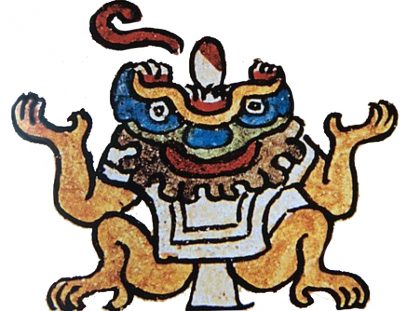
But the tongue also prays. Connects the heart back again. Maybe there is something there? “The values, attitudes, concepts and language embedded in beliefs about spirituality represent, in many cases, the clearest contrast and mark of difference between indigenous peoples and the West. It is one of the few parts of ourselves which the West cannot decipher, cannot understand and cannot control … yet.” So where does spirituality begin and end? Is it about recovery? Rivera Cusicanqui seems to hint otherwise- its less about the calcification or bemoaning, about conversion to the either side, but embracing the possibility of ch’ixi. She cites ch’ixi both as an Aymara concept of “something that is and is not at the same time”. Color contrasted on pottery- not black and white, but the grey that arises visually because of contrast- not because it is painted. And this cannot be solely a result of ancestry/lineage alone, but by self recognition of such and her “own efforts.” Simón, here is hope for the pochos! Filling in the cracks, Anzaldua brings us to nos/otras- maybe here we can breathe into the permeability of the slash. “When we adapt to cambio (change), we develop a new set of terms to identify with, new definitions of our academic disciplines, and la facultad (the ability) to accomodate mutually exclusive, discontinuous, and inconsistent worlds.”
The notion of permeability is of interest to me, because maybe, just maybe, if I can find, re-member my Coyolxauhqui body outside of the Western notions of linear time, that in cyclical time, like the snail/caracol’s spiral, I may revisit my own notions of language, self, and identiy. I might, find a pocho heart with the facultad to exist in a Pluriverse, where neither side of the border is true. Constantly divided, but still whole, I continue to dance with Coyolxauhqui. Rivera Cusicanqui proposes a road between, but not apart- “Ch’ixinakax utxiwa- The world of ch’ixi also exists“. Also is big. Also is hope. This is the logic of “an included third“- the ‘motley’ mestiza/os, who exist not just a blend (that she seems to imply as q’ara- stripped of identity), but a blend that is perceived as dual origin-ed, where both identities exist that through their juxtaposition a third arises. The world of ch’ixi also exists within me. The pluriverse starts with me.
The point is to communicate between both sides of the bordered blood. Borderhopping, codeswitching, nos guachamos, e? Erasing one half of yourself to please the other isn’t sustainable. No. Erase notions of purity. Bells on her Face- Coyolxauhqui comes, again and again. Nepantla exists because we are separated by breath. Can we come to an embracing of the distance between- the nos/otras emerging like ch’ixi, like the duets of Inuit throat singers.
What is on the other side of the river of my blood? Can the muddy waters still allow for a clear reflection, a crimson specter of possibility of multiple refractions without dispersal? Is there a truly a middle ground, an in between-ness? Is our legacy one of stable instability? Santx Anzaldua, ruega por nosotrxs.
“Tlachichiquilco in tihuih in tinemih tlālticpac: nipa centlami, nipa centlami. In tlā nipa xiyāuh in tlā noceh nipa xiyāuh ōmpa tonhuetziz: zan tlanepantlah in huīlōhua in nemōhua.”
“We travel along a mountain ridge while we live on earth, an abyss yawning on either side. If you stray too far one way or the other, you will fall away. Only by keeping to the middle way does one walk on and live.”
– an unknown ilamatlācah, “Wise Woman” quoted in Sahagún’s ‘General History of the Things of New Spain’
Oh, nepantla, en medios, neutros, our in-betweenness, our abundant middleness! Anzaldua uses it one way, Maffie expands it another. Nepanoa is the nahuatl verb “for things to intersect, unite, join together”. Manepanoa is “to marry or join hands”. Nepantla is between, liminal, but still joined! The spaces in-between the great weavings of our word-thoughts. I want to find a way for it to be less a condemnation, and more a celebration: nepantla as “dynamic, middled balance with one another“. If nepantla, is the inheritance, I have to start there.
“Tlaalaui, tlapetzcaui in tlalticpac–It is slippery, it is slick on the earth.” The earth is a dangerous place, in the eyes of the Nahua, misfortune comes easily Burkhart says. Life can be lived well, then we can easily fall. This is part of our inheritance. Part of the pocho past. And where to go, now? There are always new borders to cross. This middle way demands ch’ixi.
What is this inheritance? What is it to have multiple inheritances? Can I exist here, nepantlized, balanced in middleness, at this crossroads of histories? I invoke the spiral time invoked so strongly thus far- emotions, thoughts, curl back in on itself for López-Intzín, allowing the insult of “pinche indio” to return the heart to the forgotten cosmos. Xjul xch’ulel. For that, perhaps in my personal fence hopping through time and space, I need to go back to the beginning, or at least a beginning: to the very demand that some of my ancestors indeed love (putting the querer back in requerer) the entera noticia of El Requerimiento. This notice, written in 1513, was the Spanish solution at the guilt of conquest by translating the land and people as divinely sanctioned to be brought under Spanish rule. The Catholic (but not universal, eh?) soul is safe, as long as your victim is informed. A “love letter” from apá to amá, chingada from the start.
In naming them “terra nullius/lands of no one” and mapping them as “peopleless” voids, the uninhabitable was abstracted by cartographic translations of where and who can constitute the terms of normal habitability. This cartographic abstraction corresponded with claims to sovereignty, and the lands were perceived as legitimately appropriable in the name of the (Spanish, European) state.
A land remapped, translated through the performative power of words. Blame and guilt erased, through the performative power of words. “I certify to you that, with the help of God, we shall powerfully enter into your country, and shall make war against you in all ways and manners that we can, and shall subject you to the yoke and obedience of the Church and of their Highnesses…and we protest that the deaths and losses which shall accrue from this are your fault, and not that of their Highnesses, or ours.” And to make it official, to make it con safos, as it were, it is not only ordained by God through the authority of the Church and its sanctioned monarchs, but legally notarized at every reading. “And that we have said this to you and made this Requisition, we request the notary here present to give us his testimony in writing, and we ask the rest who are present that they should be witnesses of this Requisition.” Signed, sealed, and delivered. With a pretty papal bow, handed to you by shiny armored Spaniards.
In this theatre of conquest, who is the audience? What role the reader, what role the specta(c)tor (to borrow from Diana Taylor)? I who am both, and neither, I who am nepantlized, propose an alternative. I propose more. History is its own fiction, and lest blood fight blood inside me, I demand more of myself. Of my history. If the power of words allows the performance of manifest destiny, then perhaps the power of words may allow us chingadas to change our relationship to that inherited sense of destiny. What would it be to put the querer back into the Requerimiento? What, ch’ixi might become visible? Re + querer + y + miento. Again I want, and I lie. Perhaps this desire can be caracolized. I am not bound to the past, I cannot let it loom over me so largely that I too become “excluded from the struggles of [my] modernity.” Perhaps in this spiraling back to myself, to my past, translation is my friend. Not literal. The literal is out there. What is the past in translation? What is it to put the querer back into the Requerimiento? The amar in reclamar?
It is an offering of a heart I never had upon an altar I don’t know exists, but this is language itself, no? The abyss has stared back. Are words the offerings, like the brilliant poet Nezualcoyotl proposes, a butterflies and serpents, to the Señora y Superiora del universo mundo, the mestizaje that, like the ancient Aztec deity Tezcaltipoca, is the Necoc Yaotl – the enemy on both sides?
“Every issue has been approached by indigenous peoples with a view to rewriting and rerighting our position in history.” What is the inheritance, or the momentum, of this rewriting? The approved language of theory that defines itself by quoting itself, a hall of mirrors trapping an echo of emaciated cosmologies. (Bad poetry. And yet…) Smith insightfully problematized his-tory as culpable, fragmented, multi-chronological, deeply biased, and ultimately incoherent. So too, our language. My language. Anzaldua was so right, it is written on our bodies. It jumps back and forth in the liquid borders of our blood. Contest the contests of the past. Who con-trols the metric, con-trols the con-test.
“I’m aware of la luna, Coyolxauhqui, hovering over my house. I envision her muerta y decapitada (dead and decapitated), una cabeza con los parpados cerrados (eyes closed). But then her eyes open y la miro dar luz a los lugares oscuros, I see her light the dark places. Writing is a process of discovery and perception that produces knowledge and conocimiento (insight).”
With my apologies to Emily Dickinson, but if we’re going to re-write, let’s do it: I’m Coyolxauhqui, who are you? / Are you Coyolxauqui, too? Then there’s 400 of us! Ay, Gloria I see her too! Everywhere. And Mamá Malinche, mother of la raza, translator-traitor-grassy-llorona- I see you too. It is the returning of the heart, an offering of hearts again. Cockroach people, hijxs de la Chingada. Climbing the temple stairs, step by step, inch by inch, heart already in hand, mis pochxs.
Abuelo always said we were ‘heart-rippers’. Couldn’t erase it. So like López-Intzín call to understand Tseltal Maya Sp’ijilal O’tan, the epistemology of the heart, I have to take time. Take it. Seize. It. Unlock the progressive wheels of destination orientation, of identified routes. Breath. Embrace the cycle, and begin “returning the heart back”. There is the undeniable history: “the condition of colonized subjects and people since the Conquest” : bodies and spirits domesticated by “whips and swords” and hearts and minds through the persuasion of the clergy, but the vantage to how the archive of this history is viewed has many potential frameworks. The ways of knowledge were attacked, the sources of knowledge destroyed. Change the archive, create the world. Write, re-write, change the performance. Right, re-right, change the archive. Which side of history are you on? In this moment, where are you, my overripe pocho heart?
“If we were domesticated, is ‘de-domestication” possible?”
Corazón. Heart. But let me borrow my ancestors teyolia here, let me try to understand the o’tan- it is more than just heart, more than feeling. It is, indeed, heart-mind. Sentipensar. Ch’ulel is vital force “in every living being”; at the same time having a quality of “language acquisition and naming one’s surroundings”; it is “consciousness in general”, and also ‘collective memory’ and thusly communally negotiated and recognized. López-Intzín locates these collective experiences of the manifold ch’ulel in the o’tan- the heart. O’tan is at once both the thinker and the feeler. This is Escobar and Borda’s and Galeano’s sentipensamiento. Heart is performed to reify its heart-ness, mind is performed thus, and heart-mind includes the past, to inform the future, but not condemn the present. The pocho heart is not condemned, it is living. A living language. A life lived-living-to be lived.
It is through this sentipensar that we can maintain both an “apprehension of the world” and a “comprehension of the cosmos”. And just as the assertion that the conquest was a clash between many worlds (not just the grand mythic clash-mother of la raza), the cosmovision is here proposed in multiplicity pluriversal contextualizations. We can create, promote and encourage “the world where many worlds have a place” in self-translation. Many bodies, re-membering. Rewrite history, spiral back to the heart. Malinche, let’s do this over again. To translate the past, translates the heart.
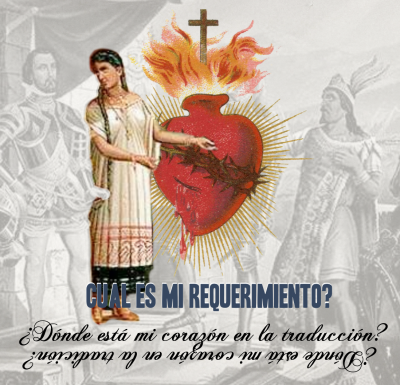
Words are re-membered, re-attached, re-envisioned. Controlling the metric. Nothing new introduces, and yet, everything new introduced, in the moment. Cyclical time, the caracol spirals back again. My breath circles back on itself. Am I stuck on this side of history? Or on this side of the future? Maybe, like Smith proposes, revisiting/re-envisioning history becomes a way to perhaps have “settled some business”. But then research, our inquiries, our how not just our whats, is culpable from the start. (Are) We are implicated by our questions (?) Yes/and. Like Smith details, history is culpable, fragmented, multi-chronological, deeply biased, and ultimately incoherent. Burn it down. Light it up. Re-light the sacred heart. Enciendelo.
On this side of the screen, staring at new friends I have yet to meet, in a program I have yet to physically attend. Subcomandante Marcos, where are you? You have made of yourself a nepantlero, now between light and shadow, understanding the power of words. You have become a pluriverse all to your own, Subcomandante Galeano is born of the nepantlized heart, born of “blood and fire“, born in a world of pochos, born in a world of masks. But he tells us directly: don’t idolize. “It is our conviction and our practice that in order to rebel and to struggle, neither leaders nor bosses nor messiahs nor saviors are necessary.” Perhaps don’t even idealize. Realize, maybe. Sentipensar-ize. Sentipensar eyes. “Choosing to cultivate life instead of worshipping death.” Choosing to rewrite/reright instead of marching towards our death.
Fruit doesn’t fall far from the tree, pochones. What came first the tree or the fruit that birthed it? Oh it’s too much to worry, translating everything to be understood keeps the pocho heart corralled, unable to cross the thousands of borders drawn around and through it. We unmask like Sup Marcos, to see the face of our re-membering. The point is to communicate- so how do you support each other? Delight in the Requirements of being pocho. “Cho[o]se rebellion, that is to say, life.” Control your metric. Con lie? Con with? Con carne? Con corazon, con mente (no miento). Con trol. Fake ’till you make it. Nothing truly is con safos, but everything may be done con respeto.
Language is masked in our zoomsemblies. Breath is masked by the literal mask. We feel our words in new ways, frustrating and frictive. Caracols within caracols. And yet still, I think of heart-ness, of ch’ulel, of o’tan. Of the personal winged soul, the teyolia. Coyolxauhqui dances still, broken, but again each month returns. We return. We re-translate. The pocho heart is an exploration of re-transaltion, of re-negotiation, of re-imagining, of re-writing, of re-righting. A chance to collect new things, mis Malinches. Until never or until forever. Cantar, y no llores, fellow Humans of the Pluriverse.
This is the apocalypse of the now, but not specific to this time (as much as we may feel it so), but always specific to each of us. (“Ah, that’s why they told me that when I was reborn, it would be as a collective.” Or maybe an apocalypse.) The pluriverse starts with each-of-us. With me. (I say it again, so I re-member!) The nepantleras, the pochos, the latina/x/e/o (ashe o….) and more- we must sacrifice the past constantly. Translate, translate again. No calcification. No ossification. No identity so fixed that it limits. If we can’t fuck with the past, then the past fucks with us. Demanding practice (not just being prisoner to theory) brings hope and movement. For-ward, (f)our-movement. We are heart-rippers, we are pochxs, we must put our immaculate, sacred hearts upon the altars of our future. Light up our apocalypti(c)orazons, let what remains after the ashes of our re-transaltions be offered to our future selves. Keep climbing the temple stairs. Help others to climb their temple stairs. Inspire, respire, con-spire. Take con-trol. Make everything floricanto, flower song, poetry. Put the querer back in requerimiento, the amar back in reclamar. [Open the/ strive to] Decolonial eyes. Sentipensar eyes. Heartbeat by pinche pocho heartbeat. Somos pochos, ¿y que?
Con respeto, c/s.
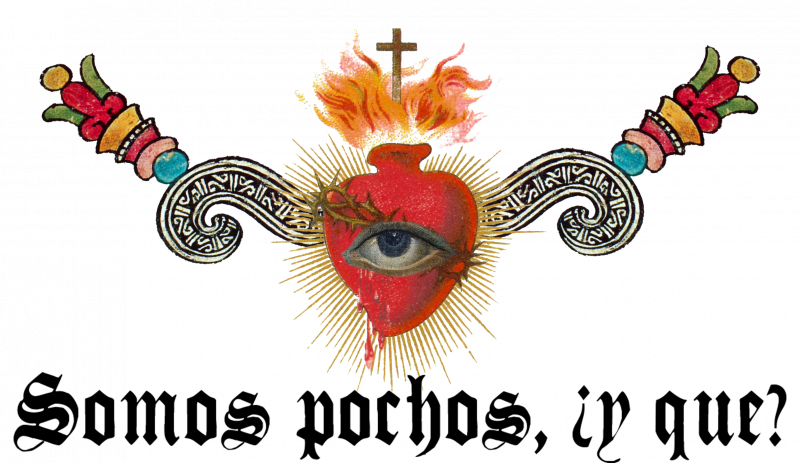
Bibliography | Works Cited
Andrade, Oswald. “Manifesto Antropófago.” Revista de Antropofagia 1. no. 1: 1928.
Anzaldúa, Gloria. Light in the Dark/Luz En Lo Oscuro. Edited by Anna Lousie Keating. Durham, NC: Duke University Press Books, 2015
Anzaldúa, Gloria. 1987. Borderlands: The New Mestiza – La Frontera. San Francisco: Aunt Lute Books, 1987.
Burkhart, Louise M. The Slippery Earth: Nahua-Christian Moral Dialogue in Sixteenth-Century Mexico. Tucson, Arizona: University of Arizona Press, 1989.
Escobar, Arturo. Pluriversal Politics: The Real and the Possible. Translated by David Frye. Durham & London: Duke University Press, 2020.
Helps, Arthur. The Spanish Conquest in America. London: John W Parker and Son, West Strand, 1855.
López Intzín, Juan. 2021. “Sp’ijilal O’tan: Knowledges or Epistemologies of the Heart.” Resistant Strategies. -. New York: Tome Press, https://resistantstrategies.tome.press/spijilal-otan-knowledges-or-epistemologies-of-the-heart/.
Maffie, James. Aztec Philosophy: Understanding a World in Motion. Boulder, Colorado: University Press of Colorado, 2014.
Marcos, Subcomandante Insurgente. “BETWEEN LIGHT AND SHADOW.” Enlace Zapatista EZLN, 1 May 2014. Web. 29 Mar 2021.
Rivera Cusicanqui, Silvia. “Ch’ixinakax utxiwa: A Reflection on the Practices and Discourses of Decolonization.” South Atlantic Quarterly, 1 Jan 2012.
Sahagún, Bernardino de. 2002. Florentine Codex: General History of the Things of New Spain. Translated by Arthur J.O. Anderson, and Charles E. Dibble. Salt Lake City, Utah: University of Utah Press.
Smith, Linda Tuhiwai. Decolonizing Methodologies: Research and Indigenous Peoples. London & New York: Zed Books, 2012
Stanzione, Vincent. Rituals of Sacrifice: Walking the Face of the Earth on the Sacred Path of the Sun. Albuquerque, New Mexico: University of New Mexico Press, 2003.
Maffie, James. 2014. Aztec Philosophy: Understanding a World in Motion. Boulder, Colorado: University Press of Colorado, Escobar, Arturo. 2020. Pluriversal Politics: The Real and the Possible. Translated by David Frye. Durham & London: Duke University Press, López Intzín, Juan. 2021. "Sp’ijilal O’tan: Knowledges or Epistemologies of the Heart." Resistant Strategies. -. New York: Tome Press, https://resistantstrategies.tome.press/spijilal-otan-knowledges-or-epistemologies-of-the-heart/. Rivera Cusicanqui, Silvia. 2012. "Ch’ixinakax utxiwa: A Reflection on the Practices and Discourses of Decolonization.." "Ch’ixinakax utxiwa: A Reflection on the Practices and Discourses of Decolonization.." The South Atlantic Quarterly 111. no. 1: 95-109. López-Intzin, Juan López. "“Sp’ijilal O’tan: Knowledges or Epistemologies of the Heart.”." Resistant Strategies 1. no. 1: Accessed 3 May 2021. Smith, Linda Tuhiwai. Decolonizing Methodologies: Research and Indigenous Peoples. London & New York: Zed Books, 2012. Print.Helps, Arthur. The Spanish Conquest in America. London: John W Parker and Son, West Strand, 1855. Stanzione, Vincent. Rituals of Sacrifice: Walking the Face of the Earth on the Sacred Path of the Sun. Albuquerque, New Mexico: University of New Mexico Press, 2003. Andrade, Oswald. "Manifesto Antropófago." Revista de Antropofagia 1. no. 1: 1928. 3-4. Burkhart, Louise M. The Slippery Earth: Nahua-Christian Moral Dialogue in Sixteenth-Century Mexico. Tucson, Arizona: University of Arizona Press, 1989. Anzaldúa, Gloria. Borderlands: the new mestiza - La Frontera. San Francisco: Aunt Lute Books, 1987. Rivera Cusicanqui, Silvia. "Ch'ixinakax utxiwa: A Reflection on the Practices and Discourses of Decolonization." South Atlantic Quarterly, 1 Jan 2012. Anzaldúa, Gloria. 2015. Light in the Dark/Luz En Lo Oscuro. Edited by AnnaLousie Keating. Durham, NC: Duke University Press Books, Subcomandante Insurgente Marcos. "BETWEEN LIGHT AND SHADOW." Enlace Zapatista EZLN, 1 May 2014. Web. 29 Mar 2021.